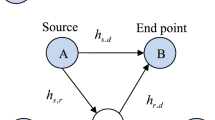Abstract
The BER performance of any wireless communication system is the primary factor of consideration for the network under evaluation. Turbo-coded OFDM systems have always outperformed other communication standards in terms of delay of communication, overall system efficiency and flexibility. But the BER performance of turbo-coded OFDM systems has always been a challenge for network designers, due to the fact that turbo encoders vary largely in terms of their primary specifications like code length and code rate among other network parameters. In this paper, we propose an artificial intelligence (AI) layer for turbo-coded OFDM systems, which improves the BER performance of the system, and also reduces the delay of communication by intelligent selection of network specifications. Our AI is trained for minimizing the BER of the communication network, but it can be used to target one or many parameters as per the requirements of the network designer.







Similar content being viewed by others
References
Tarokh V, Jafarkhani H, Calderbank AR (2006) Space-time block coding for wireless communications: performance results. IEEE J Sel Areas Commun 17(3):451–460
Jongren G, Skoglund M, Ottersten B (2002) Combining beamforming and orthogonal space-time block coding. IEEE Trans Inf Theory 48:611–627
Seshaiah CV, Nagarani S (2010) A survey on space-time turbo codes. IJCSIS 7(3):171–177
Clerk Maxwell J (1892) A treatise on electricity and magnetism, vol 2, 3rd edn. Clarendon, Oxford, pp 68–73
Hanzo L, Münster M, Choi BJ, Keller T (2003) OFDM and MCCDMA for broadband multi-user communications, WLANs and broadcasting. IEEE Press/Wiley, Piscataway
Bingham JAC (1990) Multicarrier modulation for data transmission: an idea whose time has come. IEEE Commun Mag 28(5):5–14
Chung WC, Aug NJ, Ha DS (2005) Signaling and multiple access techniques for ultra wideband 4G wireless communication systems. Wireless Commun 12:46–55
Hanzo L, Ng SX, Keller T, Webb WT (2004) Quadrature amplitude modulation: from basics to adaptive trellis-coded, turbo-equalized and space-time coded OFDM, CDMA and MCCDMA systems, 3rd edn. IEEE Press/Wiley, Piscataway
Winters JH (1984) Optimum combining in digital mobile radio with cochannel interference. IEEE J Sel Areas Commun SAC 2(4):528–539
Winters JH (1987) On the capacity of radio communication systems with diversity in a Rayleigh fading environment. IEEE J Sel Areas Commun SAC 5(5):871–878
Prabagarane N, Ashwina Y, Muralidharan P, Sabrish KV (2013) Performance of multi-user transmitter preprocessing assisted MIMO system over correlated frequency-selective channels. Phys Commun 7:6172
Alamouti SM (1998) Simple transmit diversity technique for wireless communications. IEEE J Sel Areas Commun 16(8):1451–1458
Hanzo L, Münster M, Choi BJ, Keller T (2003) OFDM and MC-CDMA for broadband multi-user communications, WLANs and broadcasting. IEEE Press/Wiley, Piscataway
Tarokh V, Naguib A, Seshadri N, Calderbank AR (1999) Bank, space time codes for high data rate wireless communication : performance criteria in the presence of channel estimation errors, mobility, and T. multiple paths. IEEE Trans Commun 47(2):199–207
Liew TH, Hanzo L (2006) Space-time trellis and space-time block coding versus adaptive modulation coding aided OFDM for wideband channels. IEEE Trans Veh Technol 55(1):173–187
Blogh J, Hano L (2002) Third generation system intelligent networking. IEEE Press/Wiley, Piscataway. http://www.mobile.Ecs.soton.ac.uk
Data communication research company (2005) Using MIMO OFDM technology to boost wireless LAN performance today. White Paper, St. Louis
Sampath H, Talwar S, Tellado J, Erceg V, Paulraj AJ (2002) A fourth generation MIMO-OFDM broadband wireless system: design, performance and field trial results. IEEE Commun Mag 40(9):143–149
Tarokh V, Seshadri N, Calderbank AR (1999) Space time block codes from orthogonal designs. IEEE Trans IT 45:1456–1467
Mohan P, Thangavel R (2013) Resource selection in grid environment based on trust evaluation using feedback and performance. Am J Appl Sci 10(8):924
Alamouti SM (1998) A simple transmit diversity technique for wireless communications. IEEE JSAC 16(8):1451–1458
Varade SW, Kulat KD (2009) Robust algorithm for DOA estimation and adaptive beamforming for smart antenna application. In: ICETET at G.H. Raisoni College of Engineering, Nagpur, 16–17 Dec 2009
Varade SW, Kulat KD (2009) Performance analysis of MVDR beamformer for smart antenna application. In: International conference on VLSI and communication, Kerala, 16–18 April 2009
Author information
Authors and Affiliations
Corresponding author
Rights and permissions
About this article
Cite this article
Subramanium, P., Raut, R.D. AI-enabled turbo-coded OFDM system for improved BER performance. J Supercomput 76, 4338–4348 (2020). https://doi.org/10.1007/s11227-018-2370-1
Published:
Issue Date:
DOI: https://doi.org/10.1007/s11227-018-2370-1




